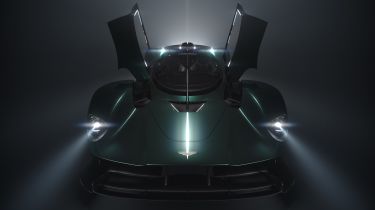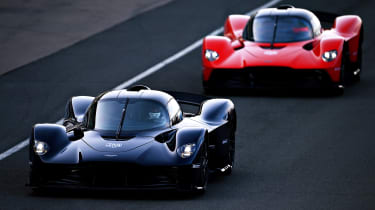Aston Martin looks set to unveil the road-going Valkyrie at Pebble Beach, where it’ll feature alongside a roster of special edition cars
Aston Martin has confirmed it will launch a new car at this year’s Concours d’Elegance at Pebble Beach on 12 August. The British brand hasn’t named the model it will unveil but, judging by the firm’s teaser image, it’ll be the road-ready version of the Valkyrie hybrid hypercar.
It’ll feature at the Monterey Car Week alongside a line-up of Aston Martin’s most exclusive models, including the newly revealed Valhalla supercar, the limited edition V12 Speedster and the £2.75 million James Bond-inspired DB5 Goldfinger Continuation, which features a host of working gadgets like those found on Sean Connery’s car in the 1964 film, Goldfinger.
Aston Martin DB5 Goldfinger: specs, gadgets and review
Although Aston Martin has already unveiled the track-only Valkyrie AMR Pro (which does without the road car’s hybrid system), the road-legal Valkyrie has been in the final stages of development for more than a year now.
The Valkyrie’s hybrid powertrain comprises a naturally aspirated 6.5-litre V12 engine, an electric motor, a lightweight battery pack and a Kinetic Energy Recovery System (KERS), which is similar to the technology found in Formula One racers. Combined, the powertrain has an output of 1,160bhp and 900Nm of torque.
Aston Martin partnered with specialists Integral Powertrain and Rimac for the Valkyrie’s hybrid technology. The electric motor is mounted in the hypercar’s gearbox, and provides 160bhp and 280Nm of torque on its own; similar figures to the most powerful 1.6-litre four-cylinder Nissan Qashqai.
Without the hybrid system, Aston Martin’s naturally aspirated 6.5-litre V12 produces 1,000bhp at 10,500rpm and 740Nm of torque at 7,000rpm, while its red-line is fixed at 11,100rpm. The engine has been developed by Cosworth with input from Red Bull Racing, using expertise gained from Formula One.
To increase the engine’s reliability, most of its internal components (camshafts, crankshaft, pistons and so on) are milled from solid material. Also, its conrods are Titanium, to help keep weight to a minimum. The result is an engine which tips the scales at 206kg.
The V12 is a structural component of the car’s chassis, which supports the rear wheels and suspension – and its removal cuts the Valkyrie in half, erasing the physical connection between the front and rear wheels.
Just 150 road-going versions of the road-going Valkyrie will be built, and all of them have already allocated owners, each paying between £2–3 million to take delivery.
Aston Martin Valkyrie: design
The Valkyrie has low and uncompromising bodywork, and is designed to be as close as possible to a road-going Formula 1 car. As such, the car’s design is dominated by the laws of aerodynamics. Two huge Venturi tunnels run either side of the cockpit, skirting around the engine. Along with two vents in the Valkyrie’s front splitter, Aston Martin say they provide “considerable gains” in downforce.
The body is lightweight, being built mainly from carbon fibre and giving the hypercar a 1:1 power-to-weight ratio. The suspension is a completely new set-up designed to be both usable on the road and able to cope with the amount of downforce the body will generate which, in AMR Pro models, is as much as 1,000kg.
The Valkyrie’s interior is a symphony of minimalism, with naked carbon fibre adorning most of the visible surfaces and a dash which only features a couple of buttons and a central touchscreen. The removable steering wheel appears to have been lifted straight from a Le Mans car, with a series of buttons and toggle switches in place of conventional stalks to operate the major controls and drive functions.
The seats are mounted directly to the carbon-fibre tub, with Aston expecting drivers to adopt a “reclined ‘feet up’ position reminiscent of today’s Formula One and Le Mans Prototype race cars”. A four-point harness will be fitted as standard, but an optional six-point system can be specified if buyers intend to spend a lot of time on the track.
A screen on the wheel acts as the instrument binnacle, while two screens attached to cameras on each side of the car act as replacements for conventional door mirrors. Rear visibility is likely to be poor, however, as the space normally occupied by the rear screen is claimed by a large engine intake.
Michelin will provide the Valkyrie’s tyres. Aston have confirmed that its hypercar will run on the French company’s Pilot Sport Cup 2 compound, sized at 265/30 ZR20 for the front and 325/30 ZR21 at the rear. The tyres will be wrapped around magnesium alloy wheels featuring race-spec centre lock nuts in a bid to reduce unsprung mass.
Aston Martin Valkyrie: technology partnerships
Alongside Cosworth and Red Bull Racing, Aston Martin drafted in Alcan and Surface Transforms, who provided the Valkyrie with a lightweight yet powerful braking system. The German technology manufacturer, Bosch, will also supply the hypercar’s Traction Control System, Electronic Stability Programme and Engine Control Unit.
The gearbox is a new design, developed by the Red Bull racing team specifically for the Valkyrie. Aston Martin’s previous CEO Andy Palmer said: “This is a no-excuses halo car – the most luxurious car in its class, but also the quickest and the fastest. This car will be able to lap the Silverstone circuit as quick as or quicker than an F1 or LMP1 car.”
Adrian Newey, Red Bull Racing’s Chief Technical Officer, also admitted that he’s wanted to build a road car for a long time; he told us that it’s an ambition he’s had since the tender age of six. “The opportunity to develop and realise those ideas with Marek and the team from Aston Martin is tremendously exciting,” he said. “It allows us to translate the technology we have developed in F1 into a new arena.”
Let us know your thoughts on the new Aston Martin Valkyrie in the comments section below…
Source: Read Full Article



 Aston Martin DB5 Goldfinger: specs, gadgets and review
Aston Martin DB5 Goldfinger: specs, gadgets and review